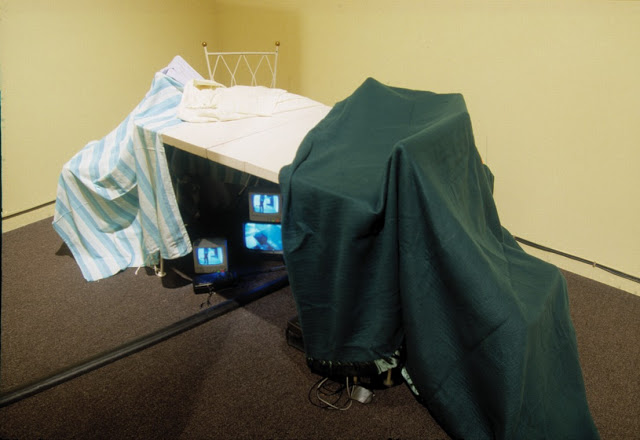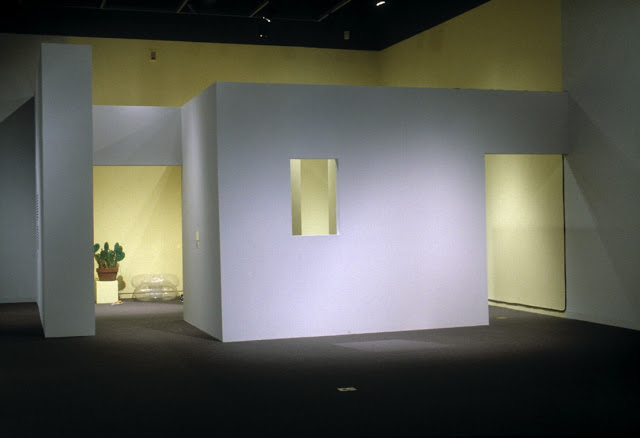
The Art of Detection: Surveillance in Society
MIT List Visual Arts Center. Curated by Jennifer Riddell.
| Cave – table, chair, blankets, monitors, radio scanners |
|
MIT List Visual Arts Gallery
Bill Beirne
Niels Bonde
Diller + Scofidio
Laura Kurgan
Richard Lowenberg
Steve Mann
Julia ScherYOU’RE THE STAR OF THE SHOW
Bill Beirne
Niels Bonde
Diller + Scofidio
Laura Kurgan
Richard Lowenberg
Steve Mann
Julia ScherYOU’RE THE STAR OF THE SHOW
Niels Bonde’s tripartite installation, unified and housed within an “apartment” setting in the gallery, manifests the psychological ramifications and conflicts of watching and being watched. The little flat’s furnishings and objects are peppered, disturbingly, with small spy cameras and radio transmitters. Some,like those contained in the stuffed animals, are small and discreet, requiring a second glance. They resemble those plush toys that are commercially available as household “plants” for concerned parents to monitor the behavior of babysitters in the parents’ absence. Others, like the radio transmitter housed in the athletic shoe, or the camera inserted into the cactus leaf, protrude in an obvious fashion.
In one view, it represents the Orwellian nightmare of total control, in which your private sanctuary the home has been sullied with surveillance devices. Is it paranoid to suspect that the devices infiltrated the home at the harnds of corporate agents wishing to demographically profile your every preference, desire, and action? Or is it that we have put them there ourselves, entranced as we are with seeing ourselves represented. Who is watching? Does it matter? Have we begun to fear that perhaps no one is watching at all?
Bonde’s installation stems from the effects of immersion within a society in which watching and being watched have become paramount to its functioning, economically and culturally. The boundaries between the producers and the consumers of imageryafforded by trickle-down technology which has put numerous digital and electronic imaging devices into the eager hands of consumers, as well as the hawklike attunement of those who shape our world culturally and visually to consumers’ desires and preferences have become blurred. The back and forth in Bonde’s installation between the sense that the privacy of its hypothetical inhabitants is being violated and the sense that they have invited the enemy into their own backyard, reinforces the fact that the boundaries between the two have dissolved. As Scher’s installation similarly suggests, there is something seductive about being the subject of all the attention: does it matter in the end that the images and information that are being gathered or that you willingly submit are being fed back to you in the form of a product that you yourself consume and even purchase?
Our insatiable appetites for cultural fare that bears our own imprimatur whether it is a home video at the backyard barbeque, MTV’s Real Life program for which the young and svelte can audition to participate (such individuals naturally giving the best impression of ” real life “!), or the curiously retro spectacle of the Today show in which tourists visiting New York throng in front of the cameras wielding signs addressed to their mother or dog, along with cakes and baseball caps for the programs hostsattests to the fact we are indeed in love with our “own” images, whether it is our own face, or the sight of “real” people, bearers of authenticity and experiences to which we can relate. Television studios are happy to comply by continuing to roll out so-called reality-based programming, which despite its moniker, bears great similarity to the usual escapist fare of commercial TV. Even celebrities to whom we cannot relate, who remain intractably part of an entertainment fantasy sphere, have taken note of people’s hunger for the product of the real, have succumbed to ever-more intimate “tell-all” interviews and ostentatiously wear jeans, uncombed hair, and no makeup to prove that they’re just like the rest of us. The media industry helps too by become ever-intruding with greater insistence into the lives of people we wish to situate in a world that is coextensive with ours (“Look! They wear the same jeans and use the same cell phone as I do!”) sometimes hounding them to death, as in the case of Princess Diana, whose demise was at least partially attributable to insatiable paparazzi.

